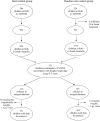Effect of treatment of gestational diabetes mellitus on obesity in the next generation
- PMID: 20150300
- PMCID: PMC2858199
- DOI: 10.2337/dc09-1810
Effect of treatment of gestational diabetes mellitus on obesity in the next generation
Abstract
Objective: Gestational diabetes mellitus (GDM) may cause obesity in the offspring. The objective was to assess the effect of treatment for mild GDM on the BMI of 4- to 5-year-old children.
Research design and methods: Participants were 199 mothers who participated in a randomized controlled trial of the treatment of mild GDM during pregnancy and their children. Trained nurses measured the height and weight of the children at preschool visits in a state-wide surveillance program in the state of South Australia. The main outcome measure was age- and sex-specific BMI Z score based on standards of the International Obesity Task Force.
Results: At birth, prevalence of macrosomia (birth weight >or=4,000 g) was 5.3% among the 94 children whose mothers were in the intervention group, and 21.9% among the 105 children in the routine care control group. At 4- to 5-years-old, mean (SD) BMI Z score was 0.49 (1.20) in intervention children and 0.41 (1.40) among controls. The difference between treatment groups was 0.08 (95% CI -0.29 to 0.44), an estimate minimally changed by adjustment for maternal race, parity, age, and socio-economic index (0.08 [-0.29 to 0.45]). Evaluating BMI >or=85th percentile rather than continuous BMI Z score gave similarly null results.
Conclusions: Although treatment of GDM substantially reduced macrosomia at birth, it did not result in a change in BMI at age 4- to 5-years-old.
Figures
References
-
- Aerts L, Van Assche FA: Animal evidence for the transgenerational development of diabetes mellitus. Int J Biochem Cell Biol 2006; 38: 894– 903 - PubMed
-
- Plagemann A, Harder T, Dudenhausen JW: The diabetic pregnancy, macrosomia, and perinatal nutritional programming. Nestle Nutr Workshop Ser Pediatr Program 2008; 61: 91– 102 - PubMed
-
- Wild S, Roglic G, Green A, Sicree R, King H: Global prevalence of diabetes: estimates for the year 2000 and projections for 2030. Diabetes Care 2004; 27: 1047– 1053 - PubMed
-
- Dabelea D, Hanson RL, Lindsay RS, Pettitt DJ, Imperatore G, Gabir MM, Roumain J, Bennett PH, Knowler WC: Intrauterine exposure to diabetes conveys risks for type 2 diabetes and obesity: a study of discordant sibships. Diabetes 2000; 49: 2208– 2211 - PubMed
-
- Silverman BL, Rizzo T, Green OC, Cho NH, Winter RJ, Ogata ES, Richards GE, Metzger BE: Long-term prospective evaluation of offspring of diabetic mothers. Diabetes 1991; 40: 121– 125 - PubMed
Publication types
MeSH terms
Substances
Grants and funding
LinkOut - more resources
Full Text Sources
Other Literature Sources
Medical


